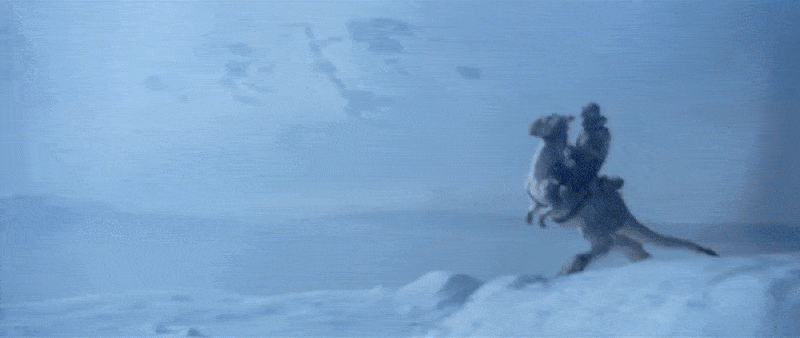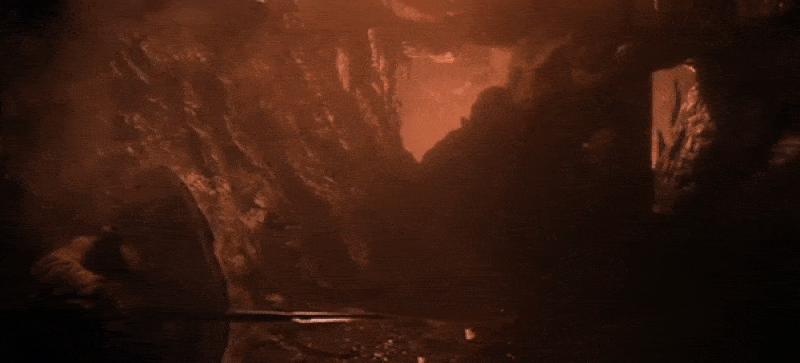Welcome to How’d They Do That? — a monthly column that unpacks moments of movie magic and celebrates the technical wizards who pulled them off. This entry explains how go-motion, the special effect pioneered by Phill Tippett, works.
I hope you all brought your tiny toolkits and wide-brimmed hats — because we’re about to do some animation archeology!
Before the early 1990s, if you wanted to include fantastical creatures, dinosaurs, or eighth wonders of the world in your movie, you had to rely on practical effects. And look, I’m a fan of man-sized suits and enormous puppets as much as the next freak. But one practical technique stands out, both as a creative medium in its own right, and one of cinema’s longest-serving special effects: stop-motion animation.
Nearly 150 years after its invention, stop-motion is still alive and kicking. And while I’d love to sit here and sing the praises of Laika and Aardman Animations for keeping the torch lit, it’s worth remembering that a significant chunk of stop-motion’s purpose didn’t make it into the 21st Century. Films like Kubo and the Two Strings (2016), Missing Link (2019), and A Shaun the Sheep Movie: Farmageddon (2019) are not aiming for realism. Stop-motion, as it exists today, is stylized, exaggerated, and not interested in convincing you that what you’re looking at is anything other than animation. But this wasn’t always the case. For a time, stop-motion’s goal was to create lifelike animated sequences that looked and moved as if they existed in the real world.
And this brings us to a fascinating, if doomed, decade in animation history: a period of time in which innovative minds sought (and arguably succeeded) in bringing stop-motion to a new level of realism right before CGI kicked the proverbial door down. As The Big Picture Magazine puts it, go-motion is a “near-forgotten transitional fossil”—an ambitious bridge between the uncanny tactility made famous by Ray Harryhausen and the kinetic fluidity we’ve become accustomed to in the digital age. Let’s take a look at how it worked:
How’d they do that?
Long story short:
By using motion-controlled articulators, go-motion allows an articulated puppet to move while the shutter of the camera is open. This creates the appearance of motion blur. The idea is to avoid the stuttery feel that sometimes comes with traditional stop-motion animation.
Long story long:
In order to fully appreciate the technical aspects of go-motion, it’s important to understand why the process was invented in the first place.
Stop-motion is a very time- and labor-intensive technique that involves photographing objects as they’re moved incrementally. When this series of images are projected at the standard 24 frames-per-second, an optical phenomenon known as persistence of vision takes over and the object appears to move (more or less) fluidly.
Whereas live-action film uses individual frames to capture movement that actually happened, stop-motion uses individual frames to capture objects frame by frame. As a consequence, stop-motion tends to create a recognizable staccato effect. This strobing takes place because the animated object is static in each frame after it is repositioned. If you were to randomly pause a stop-motion sequence, whatever frame you landed on would be perfectly sharp, which is great for grabbing screenshots but somewhat problematic for creating believable movement.
Real moving objects captured on film have motion blur because they are moving while the shutter of the camera is open. If you were to pause a video of your dog zooming on a beach, odds are that any given still frame would feature a dog-colored smudge rather than a completely sharp subject. Stop-motion animation’s lack of motion-blurring is part of what makes stop-motion look so distinctly like stop-motion. And look: this kind of jerky, deliberate movement is perfect for something inherently clunky like the 70 meter-tall bronze giant in Don Chaffey’s Jason and the Argonauts. But, by and large, this kind of stuttering can be distracting and a tell-tale sign of stop-motion’s presence. And this can be a real problem for a film hoping to seamlessly integrate live-action and stop-motion into the same sequence.
Go-motion was developed as a way to create less choppy-looking stop-motion animation. The core idea of the process involves moving the puppet or model slightly during the exposure of each frame, which produces a realistic-looking motion blur between each static re-positioning. Whereas stop-motion animation consists of images of still, incremental movements, go-motion is made up of images of the object taken in the same instant that it moves.
Animators used a variety of techniques to simulate motion blur, many of which amount to slightly jostling the puppet during the exposure of each frame without knocking everything over or moving things too much. If you’re thinking to yourself “wow this sounds even harder than just taking a bunch of photographs of a posed model” you would be correct.

Go-motion was pioneered by Industrial Light & Magic and SFX wizard Phil Tippett during the production of Star Wars: Episode V – The Empire Strikes Back (1980). During his big break on Star Wars: Episode IV – A New Hope, Tippett’s special effects tasks included a stop-motion animated effect of a gaggle of holographic figurines duking it out on a chessboard. This work opened the door for his (and Jon Berg’s) innovative work on Empire, including the Battle of Hoth, in which the Rebel’s ice base is assaulted by towering, all-terrain armored transports. As far as stop-motion is concerned, the sequence is as monumental as anything Willis O’Brien or Harryhausen ever produced. While different techniques and different-sized models were used, the fast-moving Tauntauns and the lumbering AT-AT imperial walkers both made use of go-motion, albeit in a more rudimentary form than what Tippett and ILM would later develop. For the Tauntauns (the alliance’s bipedal, camel-like creatures) puppets were moved slightly along a motion-controlled track with each opening of the camera shutter.
“Stop-motion people had for years been trying to figure out ways of adding motion-blur to things, but it was too time consuming and cumbersome, and nothing ever looked very good anyhow, up until that point,” Tippett explains in Heather A. Wixton’s Monster Squad. “When we got up to ILM and started to set up shop for Empire, it was very clear that one of the first things we had to do was experiment with combining motion-control technology that they used for the space ships, and then find a way to apply it to stop-motion characters. It ended up being a very rudimentary array that we did, where it was just kind of latching together two types of technology and seeing what they could do.”
Just as computer-controlled cameras were instrumental in elevating Star Wars’ blue-screen optical effects to new heights, the go-motion process sought to capitalize on the potential of motion-control mechanisms for animation. At its most sophisticated, go-motion involved programming a computer to move external rods that would slightly manipulate various points on a puppet during each exposure. Each rod would be attached to stepper motors linked to a computer capable of recording the movements of the model as it was animated by the puppeteers. This exposed movement, combined with traditional hand manipulation between frames, creates articulated movement with motion blur that looks pretty dang convincing.

In one sense, the timing of Tippett’s innovation was fortuitous. Star Wars exploded the demand for VFX work. And in the pre-CGI 1980s, that meant plenty of opportunities for go-motion. The technique appears in everything from the two-headed Eborsisk in Willow (1988) to the Dark Overlord monster in Howard the Duck (1986). But, for my money, the most astounding display of go-motion’s prowess is in Tippett’s first project after Empire: the 1981 sword and sorcery flick Dragonslayer. For all of Dragonslayer’s dubious optical matting, the titular dragon (whose name, I shit you not, is Vermithrax Pejorative) looks incredible. While a variety of techniques were used to bring Pejorative to life, go-motion’s boons are visible when the dragon walks on land: the enormous beast fluidly clamors through narrow caverns, scuttling furiously after our imperiled hero with none of the stuttering of his stop-motion ancestors. Engineered and animated by Tippett, Stuart Ziff, and a host of other ILM creatives, the terrestrial go-motion model of Pejorative included a complex motion control system made up of six motor-driven rods (one for each leg, one for the body, and one for the head). For proof that his movement looks identical, if not better, than any CGI dragon, we need look no further than 1991’s DragonHeart, another product of Tippett’s that lacks Pejorative’s weighty, tactile je ne sais quoi.
In something of a knife twist, Tippett was directly involved in the project that effectively made stop-motion (and by extension go-motion) obsolete: Jurassic Park. Originally, go-motion was going to be used extensively for the dinosaur effects in the film, but director Steven Spielberg ultimately opted to pursue the then-up-and-coming CGI. Tippett remained on the film, working closely with ILM’s CGI team lending both his paleontological expertise and collaborating on the Dinosaur Input Device, a traditional stop-motion armature with motion-encoders that translated physical movement into a digital model.
A look back at "Jurassic Park," the groundbreaking decision to create digital dinosaurs, and the impact it had on the future of movies. pic.twitter.com/suKZykh6NC
— The Academy (@TheAcademy) October 12, 2020
While the last proper film of the go-motion era would come a bit later in the summer of 1993 with Coneheads’ toothy Garthok, Jurassic Park marked both Tippett’s and the industry’s career-pivot into VFX. Go-motion, and all significant efforts to wield stop-motion as a viable option for realistic animated effects, went extinct. Today, mechanical motion blur is by and large a thing of the past and can now be simulated digitally in post-production (which is its own can of worms).
Notably, while the advent of credible CGI didn’t help go-motion’s survival, for its part, the technique was also prohibitively expensive. Tippett served both as RoboCop’s associate producer and an animator on the film, overseeing the sequences of the menacing, stairs-adverse enforcement droid ED-209 alongside Craig Hayes, Randy Dutra, and Harry Walton. The ED-209 effect was made up of a mostly static, seven-foot-tall, 300-pound model as well as a more articulated puppet. “We couldn’t afford Go-Motion,” Tippett tells VFX Voice. “And you know, in terms of believability, robots tend to lend themselves to the stop-motion process.” And, at the end of the day, this is the biggest takeaway: there are not necessarily “better” or “worse” techniques, only what best suits a given story (and its budget).
What’s the precedent?
The basic principle behind go-motion has supposedly been around since at least the 1920s. Legendary Polish-Russian stop-motion animator Ladislas Starevich is said to have invented the technique after settling in France. Starevich is remembered today as a pioneer of puppet-based animation, a technique he all but invented with his 1921 film The Beautiful Lukanida. He is also infamous for shooting films with animal protagonists, including the use of dead bugs with articulated wire legs.
As Mark Player notes in his 2016 article “Media-Morphosis”, Starevich’s stop-motion “was unusually fluid for the time period”. As far as go-motion is concerned, Starevich is said to have employed the “bump” technique, in which he would expose the puppet after setting it in motion to create convincing motion-blur. He is also said to have used the “move the table” technique: when a character ran, he moved the set in the opposite direction. You can see the results for yourself in a number of Starevich’s later films, including his 1937 picture The Tale of the Fox, his first fully animated feature film.
0 comments:
Post a Comment